‘Beauty in Rottenness’ and other apples
This article by Natalia Kossentino describes how she became the apple craftswoman of the Netherlands
Having been born and raised in Soviet-era Leningrad (now Saint Petersburg), I’ve lived most of my life in western Europe. When I was 19 I’d moved to Germany and now I have been living in Apeldoorn, The Netherlands for 21 years. I have a degree in painting porcelain.
In The Netherlands I became a graphic designer and founded Mycona.
I began with handiwork when I was a child. My mother told me that my first creation, a molded plastic ball with a “nose” made from a strip of pencil, called “dya-dya” (translated as “the man”), was made when I could not yet speak. I started doing it professionally about six years ago. The reason was our housecat, who not only ate all the living flowers and plants in the house, but even the artificial ones. But I still wanted to somehow decorate my house, so I started felting sculptures from wool. Then there were also carpets and matryoshkas… But a lot of people make them and I don’t like making the same things as everybody else and started looking for something of my own. In addition to wool, I also like to use other materials, such as paper and various fabrics. When I got a piece of linen in my hands I decided to make either a fruit or a vegetable. Then came the first apple.
Later, the Conaald brand appeared. (I’ve used part of the name Mycona, and added an “-ald” to form “-naald”, which means “needle” in Dutch). I have the logos of Mycona and Conaald combined with a stylized image of my housecat, in memory of him as he has passed away.
I like apples in a subconscious way. For example, my strongest childhood memory is that when I was visiting my grandmother, I climbed an old apple tree and ate green apples with a lump of sugar. In art school I often drew still lives with apples, even if there were other fruits. I just always chose them for some reason. I especially liked drawing the cross-section of an apple, because you can see a heart in an apple cut lengthwise. There is also new life in the seeds: sometimes they sprout from within. Stunning! And in a cross section you can also see a flower or a star. Another example: during my entire pregnancy I could only eat apples due to severe pre-eclampsia. And I ate a lot, up to 3 kilos per day. Now my son prefers, of all fruits, only apples. And I live in AP(P)EL-doorn. Unfortunately, the name Apeldoorn does not come from the name of my favourite fruit, it is just a coincidence.
Apples in my creations are various, sometimes in completely different styles. I divide them into two types: commercial and artistical. In the artistical style, the textile apple series “Beauty in Rottenness” was recently born. I saw the photo of an apple with mould on the internet for the first time (apples don’t stay in my house that long). And I was fascinated by how beautifully an apple can ‘age’, just like people. After all, there are people who age beautifully, for example Cindy Joseph or Daphne Selfe. Often the cause is the genes, but also a healthy lifestyle. It’s the same with apples.
I did a few “experiments” and the apples that weren’t quite fresh or had some flaws didn’t get old, but deteriorated, fast and less gracefully. The ones that were healthy and fresh gradually withered and were really pretty. And the latter I tried to make out of fabric. I usually take a piece of cloth in my hands first and it tells me what kind of apple it can become. For example, from velvet or velour I make decorative apples “The Luxury”, embroidered with beads or just velvet “Teddy apples”.
But in the case of “Beauty in Rottenness” it was the opposite. I first had the idea and then I looked for the material. I love natural fabrics, especially linen. But it wouldn’t have the shine of a real apple, so I used a synthetic fabric. And in order not to “overwhelm” the texture of the fabric and the shine, I finished with watercolour paint.
Now I am also learning to make apple blossom sprigs out of paper. My dream is to combine all my styles and materials that I like to work with in one single apple! I find inspiration everywhere, especially in nature, but it’s great to find an apple in places where you least expect it. For example, this year while on holiday in Italy I fell in love with an apple at the gate of the Sanctuary of Saint Catherine of Siena in Siena, made by Ferro Battuto Bernabei.
It’s nice to know that I am not the only one and that there are more people who love apples as much as I do.
Nederlands
Mijn naam is Natalia Kossentino. In het origineel Cosentino (veranderd vanwege de vertaling).
Ik ben geboren in Sint-Petersburg (Rusland), maar ik woon het grootste deel van mijn leven in Europa. Toen ik 19 was verhuisde ik naar Duitsland en nu woon ik al 21 jaar in Apeldoorn (Nederland).
In St. Petersburg behaalde ik een diploma als porselein schilder. In Nederland ben ik grafisch ontwerper geworden en zo is Mycona ontstaan (de naam bestaat uit een verkorte versie van mijn naam: “CoNa” COsentino NAtalia, maar deze naam was reeds op het internet bezet. Dus voegde ik nog een “my” aan “CoNa” toe. Zo is MyCoNa tot stand gekomen).
Ik begon met handwerken toen ik een kind was. Mijn moeder vertelde mij dat mijn eerste creatie, in de vorm van een bolletje kneedplastic met een “neus” gemaakt van een reepje potlood, “dya-dya” genoemd (vertaald als De man), werd gemaakt toen ik nog niet kon praten.
Ik begon het serieus te doen ongeveer zes jaar geleden. De grootste boosdoener was mijn kat, die niet alleen alle levende bloemen en planten in huis opat, maar zelfs de kunstbloemen. Maar ik wilde mijn huis toch op de een of andere manier versieren, dus begon ik sculpturen van wol te vilten. Dan waren er ook nog tapijten en matroesjka’s… Maar veel mensen maken ze en ik hou niet van “maken zoals iedereen” en ben op zoek gegaan naar iets van mezelf.
Naast wol gebruik ik ook graag andere materialen, zoals papier en diverse stoffen. Toen ik een stuk linnen in mijn handen kreeg besloot ik iets fruit-of groente te maken. Toen kwam de eerste appel. Later verscheen het merk Conaald. (Het is weer een verzamelde naam. Ik heb een deel van naam Mycona gebruikt, en een “ald” aan het eind toegevoegd -“naald”. Ik heb de logo’s van Mycona en Conaald gecombineerd met een gestileerde afbeelding van mijn kat, ter nagedachtenis aan hem.
Ik houd van appels op een onderbewuste wijze. Mijn sterkste jeugdherinnering is bijvoorbeeld dat ik, toen ik bij mijn grootmoeder op bezoek was, in een oude appelboom klom en nog groene appels at met een klontje suiker. Op de kunstschool tekende ik vaak stillevens met appels, zelfs als er andere vruchten waren, koos ik ze om de een of andere reden. Ik vond het vooral leuk om de snede van een appel te tekenen. In een in de lengte doorgesneden appel kun je een hart zien. Ook zit er nieuw leven in de pitjes. Soms ontkiemen ze van binnen. Verbluffend! En in een doorsnede kun je een bloem of een ster zien.
Of een ander voorbeeld: tijdens mijn hele zwangerschap kon ik door hevige toxicose alleen maar appels eten. En ik heb er veel van gegeten! Tot 3 kilo per dag. Nu verkiest mijn zoon, van alle fruit, alleen appels. En ik woon in APELdoorn. Alleen komt de naam Apeldoorn helaas niet van de naam van mijn favoriete vrucht, het is gewoon toeval.
Appels in mijn creaties zijn verschillend, soms in totaal verschillende stijlen. Ik verdeel ze in twee soorten: commercieel en kunst. In de kunststijl is onlangs de serie “Schoonheid in rotten” van textielappels geboren. Ik zag de foto van een appel met schimmel voor het eerst op het internet ( appels blijven niet zo lang bij mij thuis liggen). En ik was gefascineerd door hoe mooi een appel kan ‘verouderen’. Net als mensen. Er zijn immers mensen die mooi ouder worden, bijvoorbeeld Cindy Joseph of Daphne Selfe. Vaak is de oorzaak de genen, maar ook een gezonde levensstijl. Het is hetzelfde met appels. Ik heb een paar “experimenten” gedaan en de appels die niet helemaal vers waren of een of ander gebrek vertoonden, werden niet oud, maar gingen achteruit, snel en minder “mooi”. Degenen die gezond en vers waren, verwelkten geleidelijk en waren echt mooi. En deze probeerde ik van stof te maken.
Ik neem meestal eerst een stuk stof in mijn handen en die zegt me wat voor appel het kan worden. Bijvoorbeeld, uit fluweel of velours maak ik decoratieve appels “De Luxe”, met kralen geborduurd of gewoon velours “Teddy-appels”. Maar in het geval van ‘Schoonheid in verrotting’ was het het tegenovergestelde. Ik had eerst het idee en toen zocht ik het materiaal. Ik ben dol op natuurlijke stoffen, vooral linnen. Maar het zou niet de glans van een echte appel hebben, dus gebruikte ik een synthetische stof. En om de textuur van de stof en de glans niet te “overschreeuwen”, heb ik met aquarelverf afgewerkt.
Nu leer ik ook appelbloesemtakjes van papier te maken.
Mijn droom is om al mijn stijlen en materialen waarmee ik graag werk te combineren in een appel! Ik vind overal inspiratie. Vooral in de natuur.
Maar het is geweldig om een appel te vinden op plaatsen waar je het niet verwacht. Zo werd ik dit jaar in Italië verliefd op een appel aan de poort van het Heiligdom van de heilige Catharina van Siena in Siena (gemaakt door Ferro Battuto Bernabei).
En wat fijn dat ik niet de enige ben en dat er nog meer mensen zijn die net zoveel van appels houden als ik.

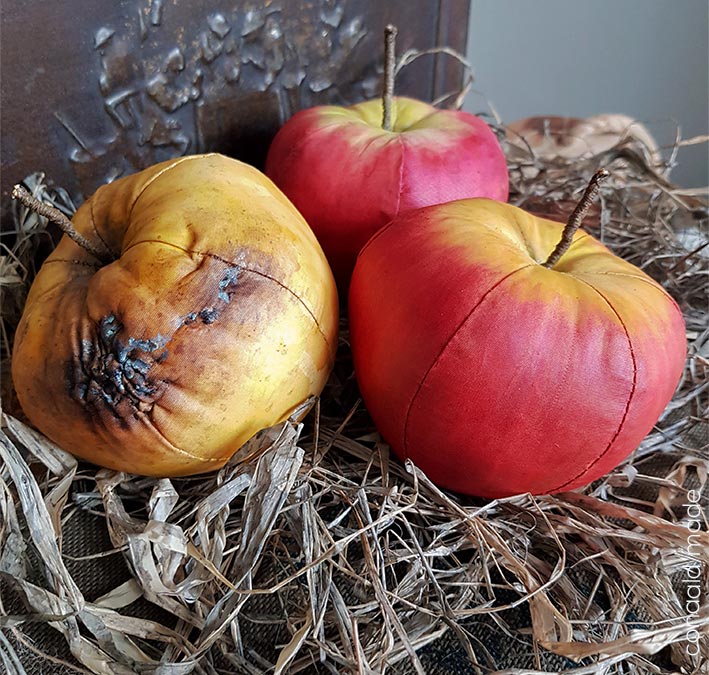
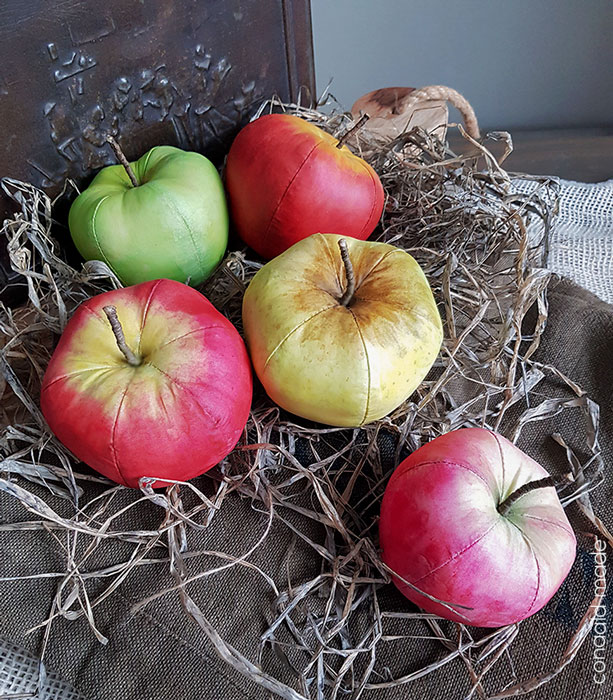
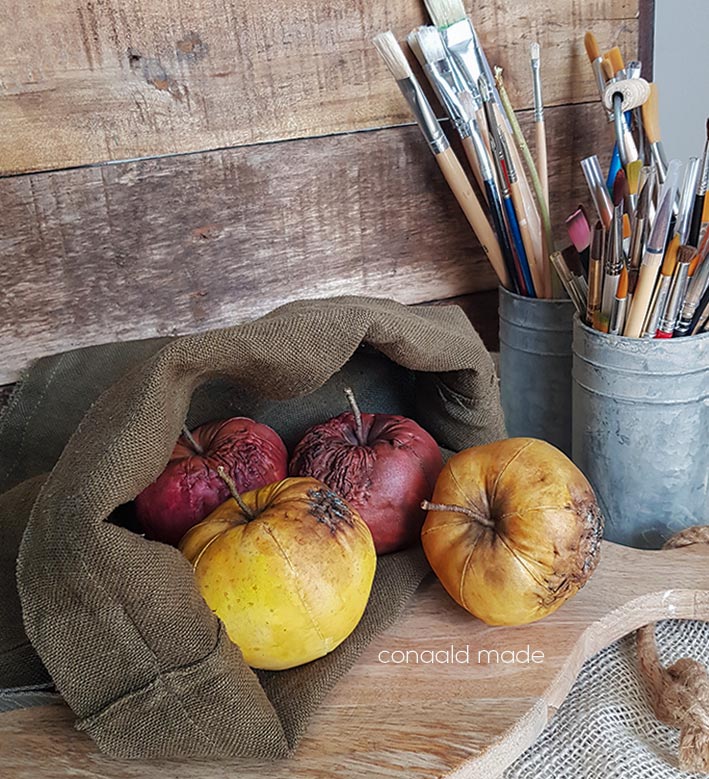
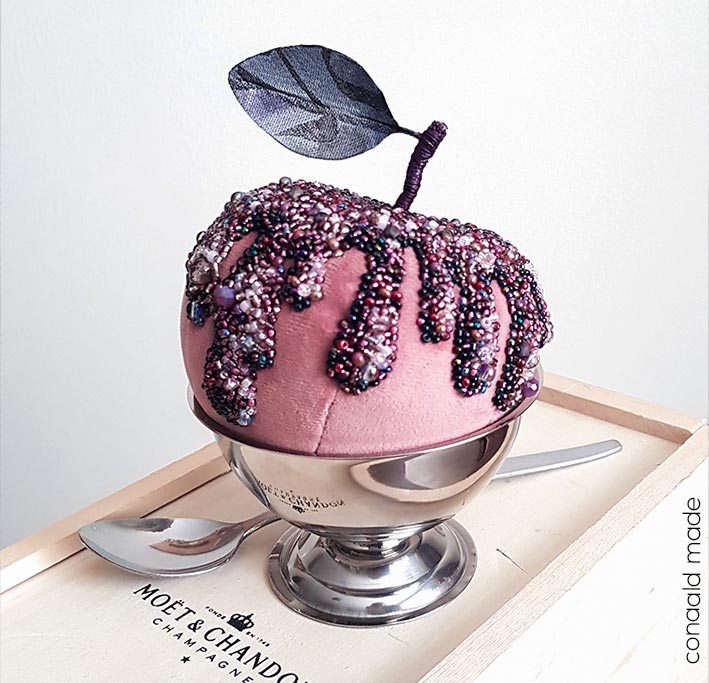
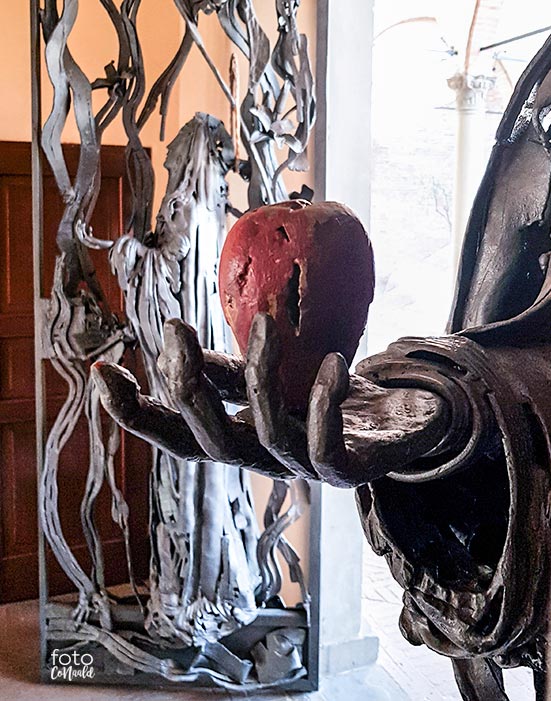


 The Apple: Served Three Ways by Tasha Marks
The Apple: Served Three Ways by Tasha Marks Golden Apples and Strudel
Golden Apples and Strudel